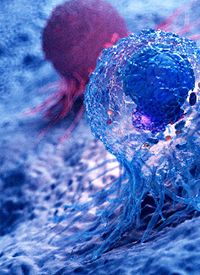Article
Chinese Phase 3 Trial of Roxadustat in Non-Myeloid Malignancies Meets Primary End Point
Author(s):
Roxadustat proved to be noninferior to recombinant erythropoietin alfa with regard to change in hemoglobin level from baseline to an average level during weeks 9 to 13 in patients receiving concurrent chemotherapy for non-myeloid malignancies in China, meeting the primary end point of an ongoing phase 3 trial.

Roxadustat proved to be noninferior to recombinant erythropoietin alfa (Sepo) with regard to change in hemoglobin level from baseline to an average level during weeks 9 to 13 in patients receiving concurrent chemotherapy for non-myeloid malignancies in China, meeting the primary end point of an ongoing phase 3 trial (NCT05301517).1
Data from the preliminary safety analysis of roxadustat were consistent with previously reported findings and indicated that the agent has a favorable benefit/risk profile when utilized in this population.
Detailed findings from the trial will be submitted for presentation at an upcoming meeting, according to FibroGen, Inc. The company also shared plans to work with AstraZeneca and the China Health Authority to file a supplemental new drug application for roxadustat in this indication.
“Roxadustat is a promising potential new oral drug for treating chemotherapy-induced anemia, which complicates the treatment of many [patients with] cancer,” Mark D. Eisner, MD, MPH, chief medical officer of FibroGen, Inc., stated in a press release. “Chemotherapy-induced anemia remains an unmet medical need in China, and we believe that roxadustat has potential to improve the lives of these patients.”
Roxadustat is a HIF-PH inhibitor that encourages coordinated erythropoiesis by boosting endogenous erythropoietin, improving iron availability, and decreasing hepcidin.2
The randomized, open-label, active-controlled, phase 3 trial enrolled patients with a histologically or cytologically confirmed non-myeloid malignancy and a baseline Hb level at or below 10 g/dL.1,3 Patients were required to weigh at least 40 kg, have an ECOG performance status of 1 or 2, ferritin of at least 50 ng/mL, and transferrin saturation of at least 10%.3
Patients could not have been receiving myelosuppressive chemotherapy with anticipated cure. If they had hematocrit of 36% or higher, received a red blood cell (RBC) transfusion or erythropoietin-stimulating agent within 4 weeks of randomization, they were excluded. Other exclusion criteria included having a thromboembolic event, pulmonary embolism, or myocardial infarction, among other conditions, within the 6 months prior to screening.
Study participants (n = 159) were randomly assigned to receive oral roxadustat or erythropoietin alfa three times per week (TIW) as part of a 12-week treatment period. The follow-up period was an additional 4 weeks. The starting dose of roxadustat was based on the weight, and the maximum dose could not exceed 3.5 mg/kg or 400 mg TIW, whichever was lower. Erythropoietin alfa had a starting dose of 150 IU/kg, given subcutaneously TIW.
In addition to the primary end point of the trial being change in Hb level from baseline to average level during weeks 9 through 13, secondary end points included percentage of patients who achieve an increase in Hb from baseline to week 13 of at least 10 g/L, percentage of patients who need RBC transfusion, average change in Functional Assessment of Cancer Therapy – Anemia Subscale Score from baseline over weeks 9 to 13, and average change in Functional Assessment of Chronic Illness Therapy – Fatigue Subscale score from baseline over weeks 9 to 13, among others.
In August 2021, roxadustat was found to have activity with favorable tolerability when used in the treatment of chemotherapy-induced anemia in patients with non-myeloid malignancies.4 The agent was reported to have met the primary end point of the phase 2 WHITNEY trial (NCT04076943), which was maximum change in Hb within 16 weeks from baseline without RBC transfusion in this patient population (n = 92).
However, more recently, the phase 3 MATTERHORN trial (NCT03263091), which is evaluating roxadustat as an anemia treatment in those with transfusion-dependent, lower-risk myelodysplastic syndrome (n = 140) did not meet its primary end point.5 Results showed that of the patients who received roxadustat, 47.5% achieved RBC transfusion independence within the first 28 weeks of treatment compared with 33.3% of those given placebo (P = .217).
Roxadustat has received regulatory approval for use in the European Union member states, including European Economic Area countries, and in Japan, China, Chile, and South Korea for use in the treatment of anemia of chronic kidney disease in adult patients, irrespective of whether they are on dialysis.1
References
- FibroGen announces positive topline results from China pivotal phase 3 clinical trial of roxadustat for the treatment of chemotherapy induced anemia. News release. FibroGen, Inc. May 18, 2023. Accessed May 18, 2023. https://investor.fibrogen.com/news-releases/news-release-details/fibrogen-announces-positive-topline-results-china-pivotal-phase
- Roxadustat: redefining how to treat anemia in chronic kidney disease. FibroGen, Inc. website. Accessed May 18, 2023. https://www.fibrogen.com/roxadustat
- A study to evaluate the efficacy and safety of roxadustat for the treatment of anemia in participants receiving chemotherapy treatment for non-myeloid malignancies. ClinicalTrials.gov. Updated May 1, 2023. Accessed May 18, 2023. https://clinicaltrials.gov/ct2/show/NCT05301517
- FibroGen announces positive topline results from phase 2 clinical trial of roxadustat for the treatment of chemotherapy induced anemia. News release. FibroGen, Inc. August 25, 2021. Accessed May 18, 2023. https://investor.fibrogen.com/news-releases/news-release-details/fibrogen-announces-positive-topline-results-phase-2-clinical
- FibroGen announces results for MATTERHORN, a phase 3 clinical study of roxadustat for the treatment of anemia in patients with myelodysplastic syndromes (MDS). News release. FibroGen, Inc. May 5, 2023. Accessed May 18, 2023. https://fibrogen.gcs-web.com/news-releases/news-release-details/fibrogen-announces-results-matterhorn-phase-3-clinical-study









